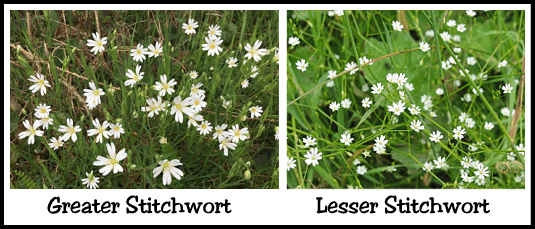
There are actually two types of Stitchwort found on Dartmoor – the Greater Stitchwort (Stellaria holostea) and the smaller Lesser Stitchwort (Stellaria graminea). Out of the two it’s the Greater Stitchwort that generates the most interest and is what this page is about. Greater Stitchwort is more commonly found in woodland edges, hedgerows and grassy areas. This plant tends to grow in patches and reaches heights of between 30 and 60 centimetres. The leaves are smooth with narrow points and appear on opposites, they also tend to have no stalks. The white flowers have five notched petals with yellow stamens and have a diameter of around 24 millimetres, these appear between April and June. The seeds are dispersed from the plant by what could be best described as an audible explosion of the seed head thus scattering the seeds far and wide.
On and around Dartmoor the Greater Stitchwort has many pseudonyms; Satin Flower, Starwort, Easter Bell, Snap Jacks, Pop Jack, Milk Maidens, Whit Suns, Break Bones, One O’ Clock, Adder’s Meat, Pickpocket, Devil’s Eyes and Piskie Flower. Some of these names are self-explanatory whilst others are less so and in some cases have differing opinions. As with other flowers ‘Adder’s meat’ is supposed to allude to the fact that should children ever pick the flower they will be bitten by a ‘Long Cripple’ better known as an adder. One theory here is that sometimes adders can be found in hedgerows etc where the Greater Stitchwort grows and should a little hand pick the flowers they could be bitten if one was at home. With ‘Pop Jack’ this name refers to the sound of the seed heads when they burst open. ‘Break Bones’ and ‘Snap Jack’ are descriptive words which implies the brittle stems and joints make such a sound when broken. ‘Easter Bells’ and ‘One O’ Clock’ probably indicate the time of year the Greater Stitchwort flowers and the time of day it’s petals are fully open. There are two opinions as to the meaning of ‘Whit Suns’, firstly its a dialect corruption of the time of year the flowers first appear – namely Whit Sunday. Alternatively once again it’s a local dialect corruption of the words White Sunday which was commonly called the second Sunday after Easter, again it’s the time of year when the flowers bloom. ‘Starwort’ quite simply is an accurate description of the shape of the flowers which may well also explain the name ‘Devil’s Eye’, it would be interesting to know who saw the devil to make such an assumption. Then we come to ‘Piskie Flower’, it is a known fact that once picked the poor flower falls into a state of collapse in about two or three minutes. Therefore as a deterrent to stop folk picking the plant it was said that should a person ever do so then that poor soul would become Piskie Led and end up stumbling about aimlessly lost and disorientated for hours. In a similar light it was also said that piskies and faeries lived amongst the plant and so it should never be picked for fear of disturbing them. Finally we come to ‘Stitchwort’ this came about by the ancient belief that it cured the pain of stomach stitches. In his book the ‘Generall Historie of Plantes’ the sixteenth herbalist John Gerade wrote; “they are wont to drinke it in wine with the powder of Acornes, against the paine in the side, stitches and such like.’ Even earlier than him Discorides another herbalist from the first century suggested that seed of the Greater Stitchwort when ground down and drunk would ensure that a pregnant woman gave birth to a son.

In a more practical sense the Greater Stitchwort’ is a veritable larder for many species of insects, bees and butterflies dine on its nectar whilst several species of moths devour the leaves.

“One that graces almost every lane through the moorland borders is Greater Stitchwort. By the time it is in full flower Spring is well under way. It has almost a hundred different English names. Many of these refer to snakes, cuckoos, pixies, stars and the Devil. Its brittle stems are recalled in such names as Snapjacks, and the belief that picking it would bring a thunderstorm about your head in the name Thunderbolts. But on Dartmoor this is above all the pixies flower…” – Hayward, J, Dartmoor 365, p.115.
 Legendary Dartmoor The many aspects past and present of Dartmoor
Legendary Dartmoor The many aspects past and present of Dartmoor
